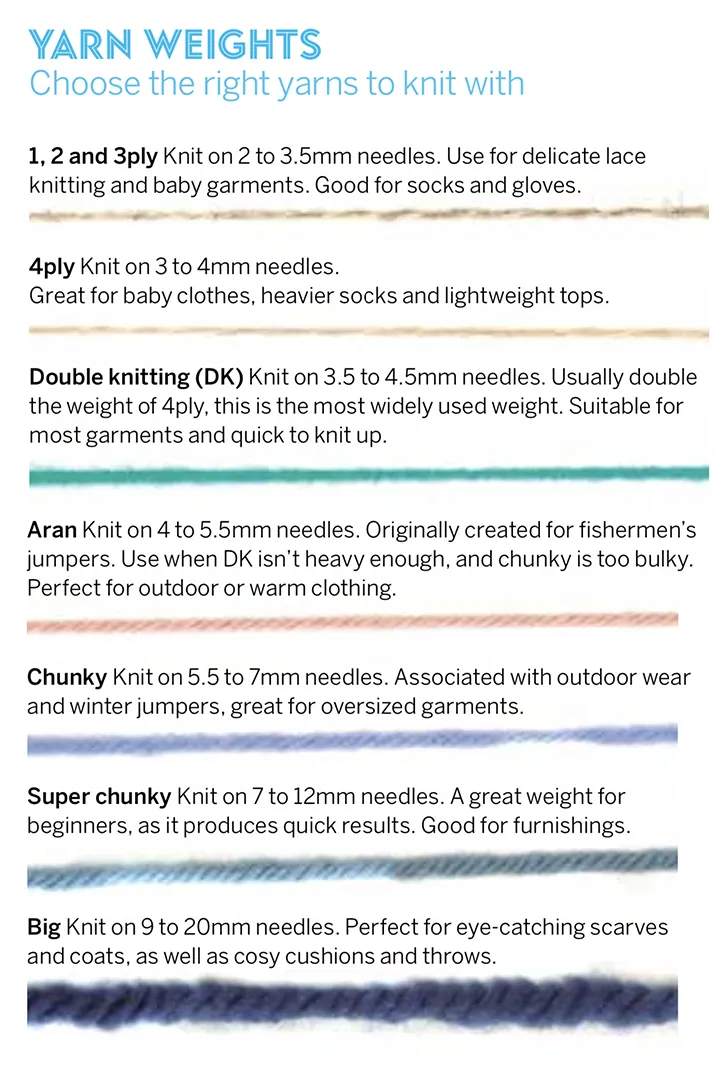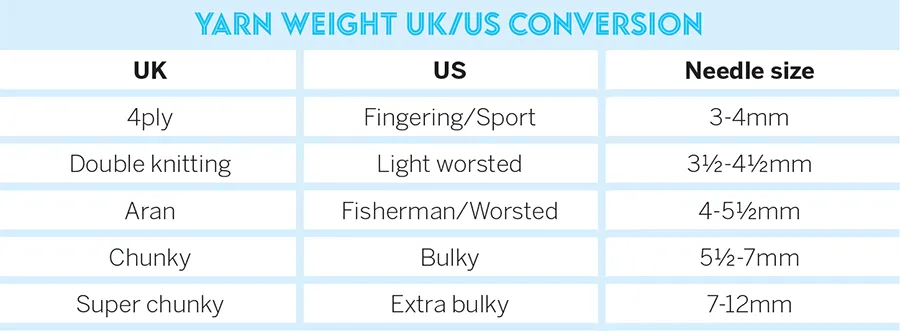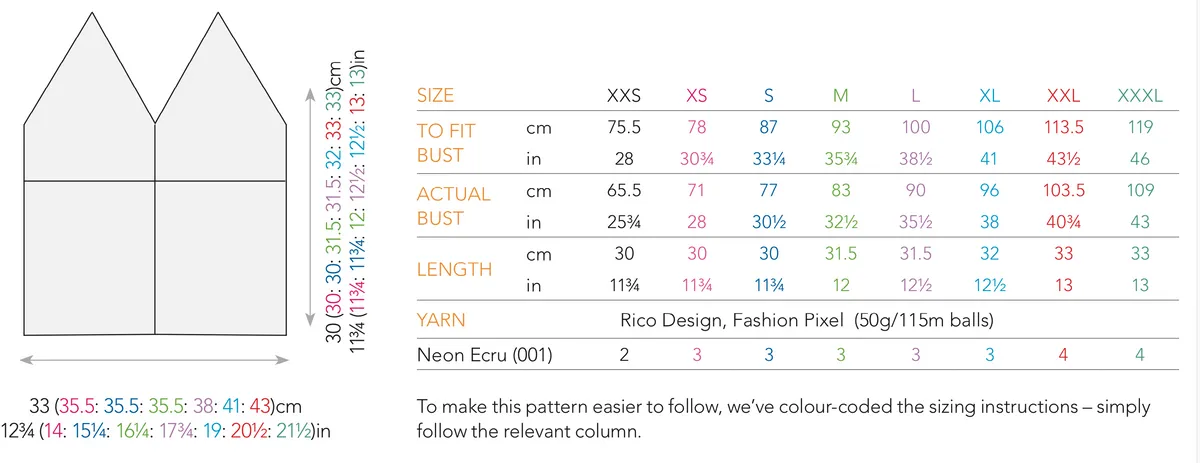Yarn weight conversion chart and beginner's guide
About to buy yarn? Read this first! Discover why a yarn’s weight isn’t about grams or kilos, and learn what terms like fingering, sport, and worsted weight really mean.
We'll take an in-depth look at yarn, covering ply and the differences between UK and US terminology. You'll also learn the basics of yarn substitution, plus how to choose the right yarn for your project using our yarn weight conversion chart.
Skip straight to...
- What is yarn weight?
- What does ply mean?
- What yarn weights are there?
- Yarn weights chart
- What is fingering weight yarn?
- What is sport weight yarn?
- What is worsted weight yarn?
- Yarn weight conversion chart
- How to convert knitting patterns if you have a different yarn weight
What is yarn weight?
When choosing the right yarn for your project, size matters. Knitting yarns come in a wide range of thicknesses, or 'weights', and the weight you choose will greatly affect the look and feel of your finished fabric.
To get the best results, it's a good idea to use the weight of yarn specified in your pattern. Tools such as YarnSub can help if you want to find a substitute.
Take care not to mix different weights of yarn in one project unless it's a novelty look you're after!
A yarn’s weight is determined by its thickness; a thin yarn like lace is considered 'light', while a thick yarn like super-chunky is 'heavy' – regardless of the ball’s actual weight.
Yarns come in a range of standard sizes (the most well-known set by the Craft Yarn Council), which are listed on the ball band along with the recommended needle size and tension. You can find our guide to these weights below.
What does ply mean?
Ply refers to the number of strands that are plied, or twisted together, during spinning to create a single strand of yarn. A 2ply yarn has two strands, a 3ply has three and so on. If you've ever untwisted or split your yarn while knitting, you'll have seen these individual plies.
Historically, yarn weights were named after these numbers. The higher the ply, the heavier the yarn, but today, it's more complex than that. A 4ply yarn might not have four plies – it could have more or fewer. And a singles (1ply) yarn could be lace weight, big or somewhere in between.
Plies are still commonly used as names for yarn weights, particularly in the UK and Australia. However, weight and ply are no longer always related!
What yarn weights are there?
Here are the yarn weights you'll most commonly encounter in the UK and our recommendations for what to knit with them. Use our yarn weight conversion chart to help translate these to US terms.
1, 2 and 3ply
Knit on 2 to 3½mm needles. Use for delicate lace knitting and baby garments. Good for socks and gloves.

4ply
Knit on 3 to 4-mm needles. Great for baby clothes, heavier socks and lightweight tops.

Double knitting (DK)
Knit on 3½ to 4½mm needles. Usually double the weight of 4ply, this is the most widely used weight. Suitable for most garments and quick to knit up.

Aran
Knit on 4 to 5½mm needles. Originally created for fishermen’s jumpers. Use when DK isn’t heavy enough, and chunky is too bulky. Perfect for outdoor or warm clothing.

Chunky
Knit on 5½ to 7mm needles. Associated with outdoor wear and winter jumpers, great for oversized garments.

Super chunky
Knit on 7 to 12mm needles. A great weight for beginners, as it produces quick results. Good for furnishings.

Big
Knit on 9 to 20mm needles. Perfect for eye-catching scarves and coats, as well as cosy cushions and throws.

Print out and keep our handy yarn weights chart

What is fingering weight yarn?
The yarn that UK knitters will be familiar with as '4ply' usually goes by the name 'fingering' in the US. You might also see it referred to as 'sock' or 'baby' weight because – you guessed it! – It's an ideal weight for socks and baby garments.
It's generally knitted on size 3-4mm needles and is a popular choice for lace shawls as it knits up into a light but cosy fabric.
What is sport weight yarn?
If you're looking at US yarn brands or patterns, you might see sport weight yarn mentioned.
There's no direct equivalent in the UK as sport weight sits between two categories: heavier than 4ply but lighter than DK.
As a result, you can generally use it as a substitute for both weights. However, make sure you swatch, swatch! Swatch first with knitting tension squares to check that your tension is a good match!
What is worsted weight yarn?
This popular yarn weight (it's reportedly the most-used yarn in the US) is equivalent to UK aran.
Worsted weight yarns are medium thickness and knit up on 4-5½mm needles. This makes them a good choice for beginners and winter knits such as jumpers and blankets. Light worsted is the same as DK in the UK.
Note that the term 'worsted' can also refer to the way the yarn is processed. It can either be worsted spun or woolen spun – so you may see it used in the context of yarn manufacturing and spinning as well.
Yarn weight conversion chart
Yarns come in a standard range of sizes, but the names can vary from country to country. Here's our at-a-glance guide to the most common yarn weights in the UK and US, and the needles to use with them:
| UK | US | Needle size |
| 4ply | Fingering/Sport | 3-4mm |
| Double knitting | Light worsted | 3½-4½mm |
| Aran | Fisherman/Worsted | 4-5½mm |
| Chunky | Bulky | 5½-7mm |
| Super chunky | Extra bulky | 7-12mm |
Print out and keep our handy yarn weight chart

How to convert knitting patterns if you have a different yarn weight
There are various reasons why you might not want to knit a pattern in the suggested yarn.
Perhaps it’s a fibre you find uncomfortable, or maybe the pattern is old, and the original yarn has been discontinued. Or maybe you just want to change the design or use yarn from your stash instead of buying new.
There are a few things to consider when substituting yarns – including a bit of maths! The easiest option is a 'like for like' swap, using a yarn of the same weight. However, if the new yarn is sold in different lengths, you may need to do some quick calculations to determine how much you'll need.
Tension squares
For more significant changes, it’s best to experiment with plenty of tension squares and to consider the finished effect – details such as cabling won’t show up with a fluffy yarn, for instance. But you can work out how to convert a knitting pattern to a different yarn weight by knitting tension squares.
If you don’t have the same tension as the pattern, you will not be able to reach the stated pattern dimensions by following the printed instructions.
First, you must knit your new swatch in the yarn or to the tension you want to work with. This will be the fabric your project is made from and must be large enough to accurately measure your new tension from.
The standard swatch size is 10cm x 10cm (4in x 4in). However, if your project features a complex motif or texture, ensure your swatch includes at least one full pattern repeat, with extra space around the edges to prevent distortion. Wash your swatch as you would the final project, then let it dry before measuring.
To calculate the new stitch counts, divide the old stitch count by the old tension, then multiply by the new tension for each row. The pattern schematic shows the key garment measurements that must remain the same, regardless of tension.

Here's the pattern schematic for our knit crop top pattern. Checking the width at different parts of the design lets you check measurements are what you expected them to be even after you have converted your yarn weight.

Check the width of your garment at particular points to confirm that it matches what you would expect to see with the pattern schematics. It's really helpful to see instructions like “continue until work measures x cm” in your original pattern. As that’s a fixed measurement, we can use that as a guide for our new yarn weight, too.
You're now a yarn weight expert
You now have the tools to figure out yarn weight and conversions, but as you might imagine, it's not an exact science. You will occasionally come across yarns that are not quite clear – is it a thick DK or a thing Aran?
But now that you have the skills, you can figure out how to make that yarn work for you, even if the yarn band is long gone.
More knitting advice
If you're new to knitting, patterns can look like they're written in another language. But don't worry, we're here to translate!
Whether you're on your first project or just need a quick refresher, check out our knitting abbreviations for the common stitches you'll find in our patterns. From 'alt' to 'yo', it's all there.

